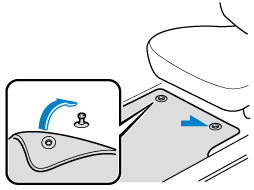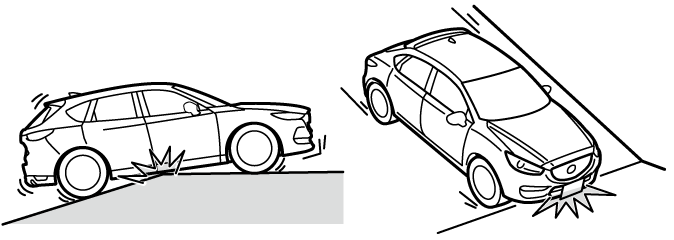Driving Tips
Break-In Period
No special break-in is necessary, but a few precautions in the first 1,000 km (600 miles) may add to the performance, economy, and life of the vehicle.
-
Do not race the engine.
-
Do not maintain one constant speed, either slow or fast, for a long period of time.
-
Do not drive constantly at full-throttle or high engine rpm for extended periods of time.
-
Avoid unnecessary hard stops.
-
Avoid full-throttle starts.
-
Do not tow a trailer.
Floor Mat
We recommend the use of Genuine Mazda floor mats.
Make sure the floor mats are hooked on the retention pins to prevent them from bunching up under the foot pedals:
Using a floor mat that is not secured is dangerous as it will interfere with the accelerator and brake pedal operation, which could result in an accident.
Do not install two floor mats, one on top of the other, on the driver's side:
Installing two floor mats, one on top of the other, on the driver's side is dangerous as the retention pins can only keep one floor mat from sliding forward.
Loose floor mat(s) will interfere with the foot pedals and could result in an accident.
If using an all-weather mat for winter use always remove the original floor mat.

When setting a floor mat, position the floor mat so that its grommets are inserted over the pointed end of the retention posts.
Winter Driving
Carry emergency gear, including tire chains, window scraper, flares, a small shovel, jumper cables, and a small bag of sand or salt.
Ask an Authorized Mazda Dealer to check the following:
-
Have the proper ratio of antifreeze in the radiator.
Refer to Engine Coolant (Search).
-
Inspect the lead-acid battery and its cables. Cold reduces lead-acid battery capacity.
-
Use an engine oil appropriate for the lowest ambient temperatures that the vehicle will be driven in (Search).
-
Inspect the ignition system for damage and loose connections.
-
Use washer fluid made with antifreeze―but do not use engine coolant antifreeze for washer fluid (Search).
-
Remove snow before driving. Snow left on the windshield is dangerous as it could obstruct vision.
-
Do not apply excessive force to a window scraper when removing ice or frozen snow on the mirror glass and windshield.
-
Never use warm or hot water for removing snow or ice from windows and mirrors as it could result in the glass cracking.
-
Drive slowly. Braking performance can be adversely affected if snow or ice adheres to the brake components. If this situation occurs, drive the vehicle slowly, releasing the accelerator pedal and lightly applying the brakes several times until the brake performance returns to normal.
Driving In Flooded Area
Dry off brakes that have become wet by driving slowly, releasing the accelerator pedal and lightly applying the brakes several times until the brake performance returns to normal:
Driving with wet brakes is dangerous. Increased stopping distance or the vehicle pulling to one side when braking could result in a serious accident. Light braking will indicate whether the brakes have been affected.
Do not drive the vehicle on flooded roads as it could cause short circuiting of electrical/electronic parts, or engine damage or stalling from water absorption. If the vehicle has been immersed in water, consult an Authorized Mazda Dealer.
Overloading
Be careful not to overload your vehicle:
The gross axle weight rating (GAWR) and the gross vehicle weight rating (GVWR) of the vehicle are on the Motor Vehicle Safety Standard Label on the driver's door frame. Exceeding these ratings can cause an accident or vehicle damage. You can estimate the weight of the load by weighing the items (or people) before putting them in the vehicle.
Driving on Uneven Road
Your vehicle's suspension and underbody can be damaged if driven on rough/uneven roads or over speed bumps at excessive speeds. Use care and reduce speed when traveling on rough/uneven roads or over speed bumps.
Use care not to damage the vehicle's underbody, bumpers or muffler(s) when driving under the following conditions:
-
Ascending or descending a slope with a sharp transition angle
-
Ascending or descending a driveway or trailer ramp with a sharp transition angle

This vehicle is equipped with low profile tires allowing class-leading performance and handling. As a result, the sidewall of the tires are very thin and the tires and wheels can be damaged if driven through potholes or on rough/uneven roads at excessive speeds. Use care and reduce speed when traveling on rough/uneven roads or through potholes.










































